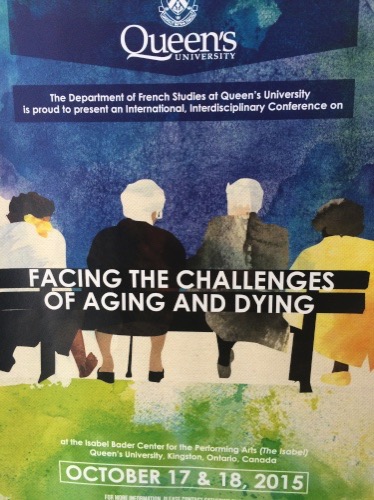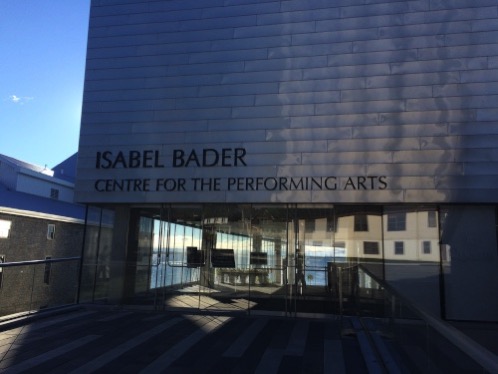
Catherine Dhavernas (French Literature, Theory, Queen’s University) and Janet Dunbrack (Board Chair, Hospice Care, Ottawa) organized a conference on Aging and Dying. I attended this conference noting that increasing numbers of my patients are considered aging. Indeed I’m considered Aging.
It’s been many years since I studied with Elizabeth Kubla Ross and increasingly I have patients dealing with dying parents. Personally I am feeling my age as loss. Once extremely fit and athletic a series of injuries in the last few years have taken far too long to recover from. The aches and pains remain and on top of that some fat old man seems to have invaded my body. Where once I’d love to run today I walk and actually prefer to ride. I’ve had the loss of some smell after a particularly severe sinusitis and added to that is thinning hair and some mild hearing loss. It has given new meaning for me personally to the classic Canadianism, “eh?"
My older brother, the rock of the family, the one who lead the way through childhood, the one who protected me in cubs and scouts, had a near death experience with a pulmonary embolism and subsequent discovery of pancreatic cancer. Queen’s University oncology department doctors have been the best. He’s responding to chemotherapy now. We only just buried the ashes of my father and mother who died separately these last few years. It was my brother who dealt with the bureaucracy of the funeral parlour and graveyard who tried to insist that only my mothers ashes, not a mix of my mother and father’s ashes were ‘reserved’ a space in their prestigious graveyard. It was my brother’s wisdom and patience that solved the problem waiting till the right time to stroke the outstretched palm, knowing that this was all it was ever about. Baksheesh, The trade in the dead. My suggestion, typical through life, that I’d add some more corpses to their precious graveyard had been tempered by my brothers understanding and acceptance. He’s been a voice of reason always.
As a psychiatrist who has helped stop literally hundreds from killing themselves I’ve been depressed with the Supreme Court’s new ‘physician assisted suicide’ stance. I took an oath to ‘do no harm’ and the weasel words of their decision seem less logic and more convenience. The UN Agenda 21 has invaded courts and bureaucrats like cancer offering death in the name of life wherever it goes. I was excited by this conference because it promised to address this topic. One of the leading lawyers involved in Quebec’s euthanasia program was to be a speaker as was the University of Toronto's leading medical authority on palliative care.
Nearly 25 years ago I’d been condemned for recommending ‘palliative care’ for a patient only to find that the doctor and nurse who were claiming to be more caring and more concerned than me and clinically wiser, were doing pharmaceutical company experiments on the elderly and demented for kickbacks without consent. As so many were making such big money I was lucky at the time to keep my license, finding no friends in the very places where people were on high government pay to protect the lives and dignity of patients. The practice stopped, I was ‘set free’, I was hated by those who had lost a prime source of income and considered stupid for not accepting the lucrative olive branch offered to me to turn away. I was thereafter designated a ‘non team player’ and suspect as ‘disloyal’. Palliative care meanwhile was what was appropriate for my patient and supported by her family. So in the end Palliative Care won out. It’s today a cornerstone of end of life care and thinking. Yet I know this wasn’t always the case from my personal horrendous experience.


The conference was held at the beautiful Isabel Bader Conference Centre at Queen’s University. A truly lovely location with wonderful views of Lake Ontario and state of the art facilities. Not surprisingly the symphony performs there which explains to some extent the elegance and sense of refinement that permeated the facility.

The originators of the conference , Catherine Dhavernas (French Literature, Queens) and Janet Dunbrock (Board Chair, Hospice Care, Ottawa)
opened the morning sessions.
“Aging and dying are a reality central to the human condition”. The greater significance of this now is that ‘with growing aging population…raising the awareness (with) sense of priority and care they deserve…and belief in multidisciplinary exchange with an awareness of barriers."
She saw that the arts and humanities could work with the health professionals ,noting that her own interest and awareness had resulted from her volunteering to assist in the palliative care unit.
She introduced the topic of “Narrative Medicine”, and described how ‘literary studies help develop awareness."
She quoted Rita Charon, Narrative Medicine, Honouring the Stories of Illnesss, 2005
Rita Charon, Narrative Medicine, Honoring the Stories of Illness 2006
-“We clinicians act as ventriloquists to give voice to that which the patient emits. I put it that way because the patient cannot always tel, in logical or organized language that which must be told. We let the other talk through us, finding the words in which to say that which cannot be said.”
“No story is possible, if by story one means: to tell a story of events which makes sense>”
Sarah Kofman, Smothered Words
“Does medicine have to overlook the unknown? was the question raised.
Drawing from works of Marguera Yourcenar the Abyss, the movement from ‘self to other’ was discussed with the origins of the essence of ‘palliative care’ underlined. “the patient in the throes of death….acknowledges the unknown and unknowable….nonverbal only viable way to care for patient - invisible inarticulable care."
“our society, aging, denies unknown….promotes youth in denial."
It was a deeply moving presentation that raised all manner of considerations for me a physician.
They stated ‘Our hope is to open discussion across various disciplines to recognise aging and death."
The conference certainly did this for me.
I was moved by the pictures of the events of dying, the changes in perception over time and culture. Each presenter was excellent. I had come to hear mostly the University of Toronto physician discussing palliative care in light of the new physician assisted suicide changes in law. There was a snag in the technology but I was delighted by how the planners rose above these post modern difficulties with almost medieval persistence. The presentation was all I could have hoped for. I had also been most interested to learn from the lawyer who spoke on the Quebec legal experience of euthanasia. What was so satisfactory to learn was that ‘Palliative Care’ was enshrined in the laws In Quebec. Euthanasia was not something to be offered to the poor while the rich got Palliative Care. The law demanded that the highest forms of Palliative Care be provided.
Now that said, I as a pragmatist and scientist was most impressed by the presentations by the ‘flaky’ arts faculty. Rather than ‘soft’ their presentations were hard and to the point. I was truly challenged by the presentation on Caravaggio discussing the actual sense of timing and time as it changed. We have used ideas in science of brain death and such but here was a truly enriching consideration of the history of this idea of time and timing as related to art history. Who would have thought!
(Instant of Never-Ending Death : Divergent Trajectories in Caravaggist Art
Itay Sapir
Art History
Universitye due Queebec a Montreal
Issues around death
-public versus private
-right to death
-technology)
I loved the whole idea of Ars Morendi and was thankful to learn of this. The discussion of the art of different periods and the ideas of what was important in the day and age most interesting.
(Ars moriendi - The Art of Dying in the Middle Ages
Thekla-Christine Hansen, M.A.
Art Historian , Mail: thekla.handsen@gmx.de
Christian-Albrecht-Universitat Kiel
Plan
preconditions - living conditions, medicine
-ideas of afterlife in medieval times
Ars Moriendi- the art of dying well)
I loved the art and presentation and discussion of present day views of aging. Indeed, when the somewhat fat old white guy torso was put on the screen I wondered for a paranoid instant who’d been taking pictures in my bathroom. Yet, seeing this, I felt less ‘shame’ in my definitely changed look from the days when I too was young. It struck home viscerally how much we are a youth culture and how ‘other’ I felt until hearing and seeing this. I intellectually know this and yet the art and this presentation touched me in that experiential place where I went aha. This was a great presentation.
(The Art of Aging in the Photography of John Coplans, Suzy Lake and Cindy Sherman
-Meghan Bissonnette
Lecturer, Art History, Valdosta State University
Contemporary artist who —represent aging
- aging as beautiful -
- coming of age - art and science - show - heartfelt/dignified/beautiful
- rarely do we represent stigma - aging as sentimentalized
- artist who take more critical stance
- beyond stereotypical )
Finally , I loved Downar quoting Woody Allen, “I don’t mind dying, I just don’t want to be there."
The conference was a day and a half. Unfortunately I had planned my flights originally flying out of Kingston but had changed to leaving Toronto so was unable to attend the morning conference. I did enjoy the lunch and breakfast time which in ages gone by we called ‘mixers’. There was a reception to and a celebration of the new courses and master program in Aging that had begun at Queen’s. I do hope they continue this conference and would recommend it to all those who work with an aging population or have an special interest in aging and dying. I’m very thankful to have attended




No comments:
Post a Comment